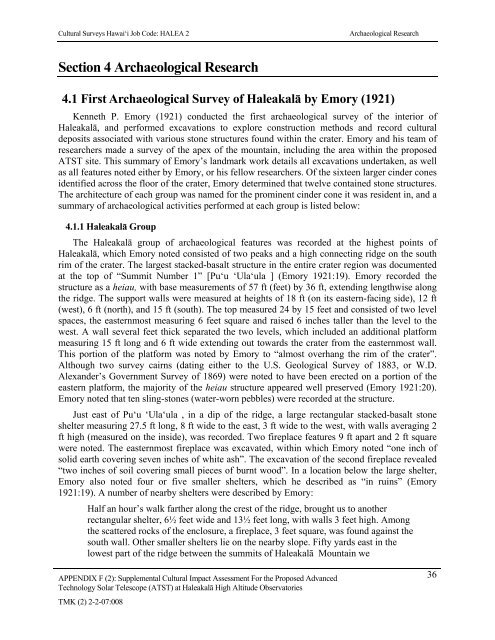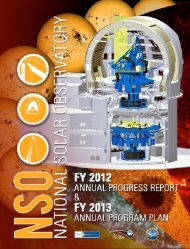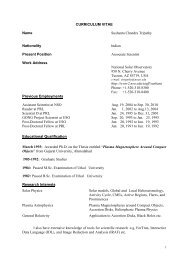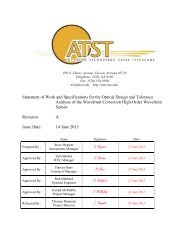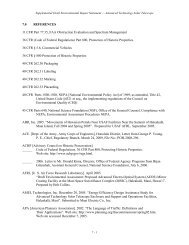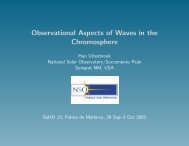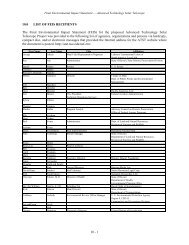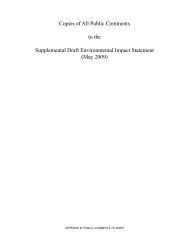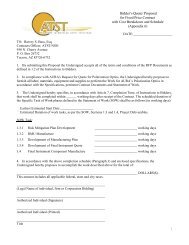F2 - ATST
F2 - ATST
F2 - ATST
Create successful ePaper yourself
Turn your PDF publications into a flip-book with our unique Google optimized e-Paper software.
Cultural Surveys Hawai‘i Job Code: HALEA 2Archaeological ResearchSection 4 Archaeological Research4.1 First Archaeological Survey of Haleakalā by Emory (1921)Kenneth P. Emory (1921) conducted the first archaeological survey of the interior ofHaleakalā, and performed excavations to explore construction methods and record culturaldeposits associated with various stone structures found within the crater. Emory and his team ofresearchers made a survey of the apex of the mountain, including the area within the proposed<strong>ATST</strong> site. This summary of Emory’s landmark work details all excavations undertaken, as wellas all features noted either by Emory, or his fellow researchers. Of the sixteen larger cinder conesidentified across the floor of the crater, Emory determined that twelve contained stone structures.The architecture of each group was named for the prominent cinder cone it was resident in, and asummary of archaeological activities performed at each group is listed below:4.1.1 Haleakalā GroupThe Haleakalā group of archaeological features was recorded at the highest points ofHaleakalā, which Emory noted consisted of two peaks and a high connecting ridge on the southrim of the crater. The largest stacked-basalt structure in the entire crater region was documentedat the top of “Summit Number 1” [Pu‘u ‘Ula‘ula ] (Emory 1921:19). Emory recorded thestructure as a heiau, with base measurements of 57 ft (feet) by 36 ft, extending lengthwise alongthe ridge. The support walls were measured at heights of 18 ft (on its eastern-facing side), 12 ft(west), 6 ft (north), and 15 ft (south). The top measured 24 by 15 feet and consisted of two levelspaces, the easternmost measuring 6 feet square and raised 6 inches taller than the level to thewest. A wall several feet thick separated the two levels, which included an additional platformmeasuring 15 ft long and 6 ft wide extending out towards the crater from the easternmost wall.This portion of the platform was noted by Emory to “almost overhang the rim of the crater”.Although two survey cairns (dating either to the U.S. Geological Survey of 1883, or W.D.Alexander’s Government Survey of 1869) were noted to have been erected on a portion of theeastern platform, the majority of the heiau structure appeared well preserved (Emory 1921:20).Emory noted that ten sling-stones (water-worn pebbles) were recorded at the structure.Just east of Pu‘u ‘Ula‘ula , in a dip of the ridge, a large rectangular stacked-basalt stoneshelter measuring 27.5 ft long, 8 ft wide to the east, 3 ft wide to the west, with walls averaging 2ft high (measured on the inside), was recorded. Two fireplace features 9 ft apart and 2 ft squarewere noted. The easternmost fireplace was excavated, within which Emory noted “one inch ofsolid earth covering seven inches of white ash”. The excavation of the second fireplace revealed“two inches of soil covering small pieces of burnt wood”. In a location below the large shelter,Emory also noted four or five smaller shelters, which he described as “in ruins” (Emory1921:19). A number of nearby shelters were described by Emory:Half an hour’s walk farther along the crest of the ridge, brought us to anotherrectangular shelter, 6½ feet wide and 13½ feet long, with walls 3 feet high. Amongthe scattered rocks of the enclosure, a fireplace, 3 feet square, was found against thesouth wall. Other smaller shelters lie on the nearby slope. Fifty yards east in thelowest part of the ridge between the summits of Haleakalā Mountain weAPPENDIX F (2): Supplemental Cultural Impact Assessment For the Proposed Advanced 36Technology Solar Telescope (<strong>ATST</strong>) at Haleakalā High Altitude ObservatoriesTMK (2) 2-2-07:008


